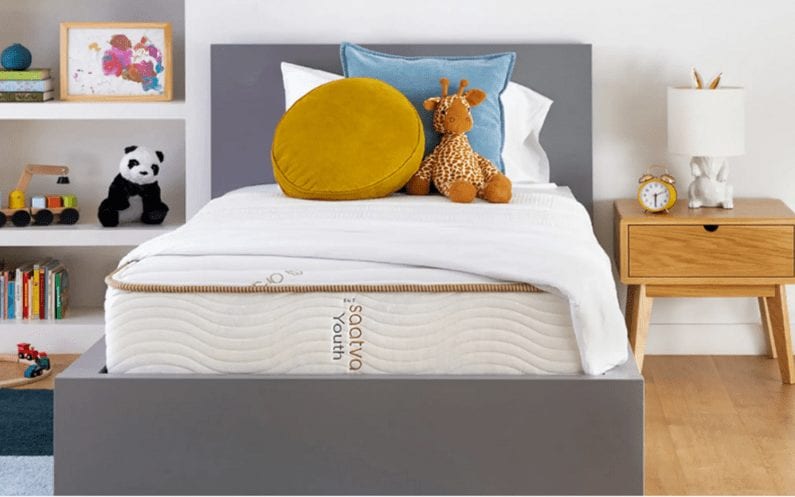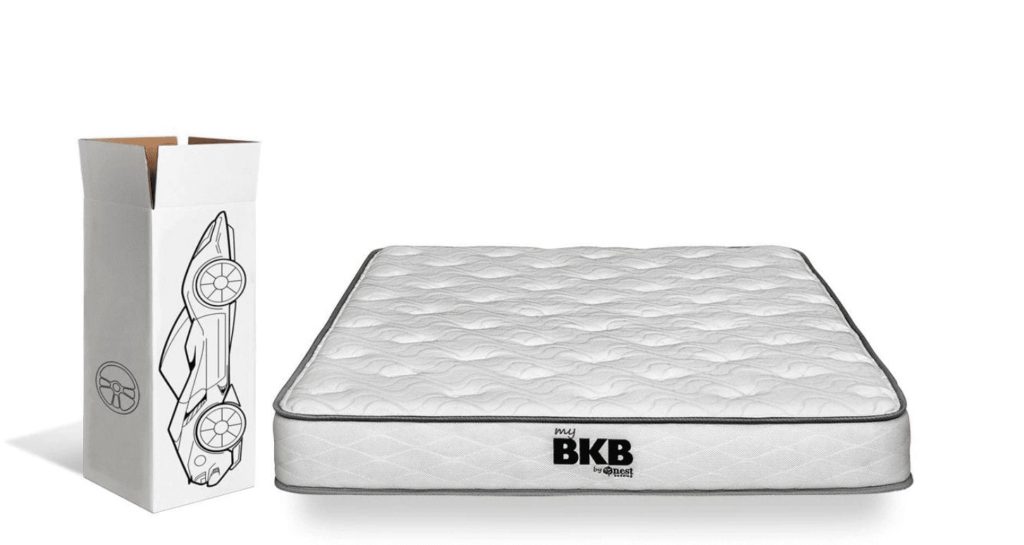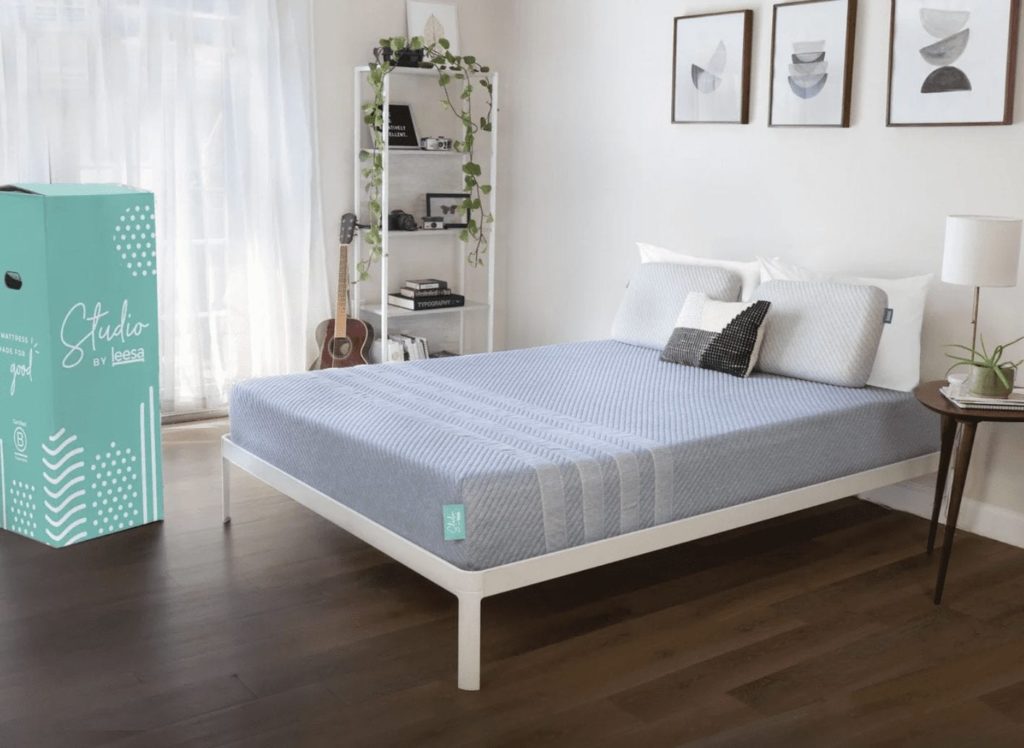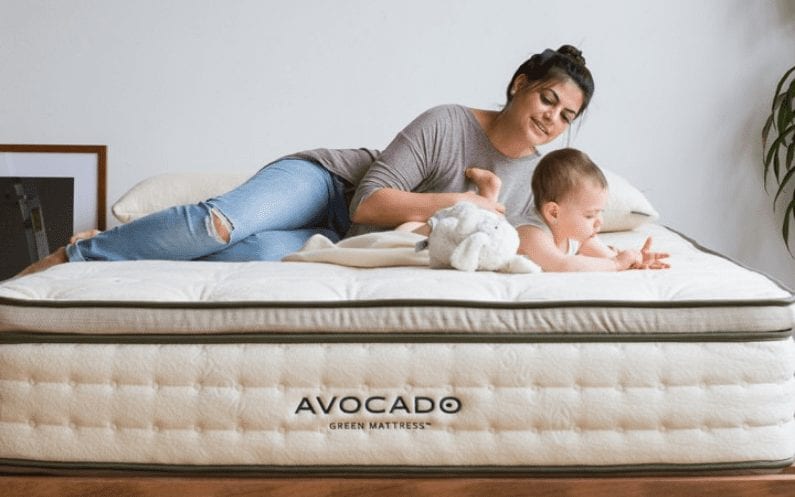The Best Mattress for Kids, Based On The Sleep Doctor’s Expert Input
Sleep is an invaluable aspect of health and wellbeing for adults, but it’s especially important for kids. Studies show kids who consistently get quality rest have improved attention, behavior, and memory, but a shocking 50% of kids aged 6-17 aren’t getting enough sleep. That’s why it’s crucial they rest on a bed that supports their growth. By investing in the best mattress for kids, you can ensure your child rests comfortably, so they can have enough energy to carry them through school, sports, and playdates with friends.
“It has always amazed me––so many parents spend as little money as possible on a bed or keep their children in a twin, when their feet are hanging off the edges. It’s nuts! A child’s physical, mental and even spiritual development are all affected by their sleep, and with childhood being such an important developmental time in life, a child’s bed simply MUST be the best it can be,” says Dr. Breus.
Michael Breus, Ph.D., board-certified sleep specialist known as The Sleep Doctor has teamed up with the experts at Mattress Advisor to find the top picks for kids. All of these mattresses are available online for added convenience and promise a quality night’s rest for your child.
Each product we feature has been independently selected and reviewed by our editorial team. If you make a purchase using the links included, we may earn commission.
The 8 Best Mattresses for Kids
- Best Growing Kids: Saatva Youth
- Best for Toddlers: Big Kid Bed by Nest Bedding
- Best Memory Foam Mattress: Nectar
- Best for Active Kids: Bear
- Best for Combination Sleepers: Brooklyn Bowery
- Best Twin Mattress: Tuft & Needle
- Best for Stomach Sleepers: Leesa Studio
- Best Organic: Avocado
Sleep and Growing Kids – Why It’s Important
Kids days are jam packed with school, sports, and extracurricular activities, so it’s crucial they get the rest they need at night to restore their growing bodies. Not only does sleep help promote proper physical and mental development for kids, but it also helps children avoid health problems. Lack of sleep has been linked with childhood obesity, high blood pressure, and even depression. According to The Sleep Doctor, kids in the three-to-five-year range need anywhere from 10 to 13 hours of sleep each day, while children six to 12 need at least nine hours. If your child isn’t getting the proper amount of sleep each night, they’re at risk for insufficient sleep. Take a look at the chart below if you need help figuring out how much sleep your child should be aiming for each night.
| Age | Hours of Rest Needed | Naps | |
| Toddlers | 1-2 years | 11-14 hours | Typically need 2 daytime naps, but as toddlers get older they may only need 1 |
| Preschoolers* | 3-5 years | 10-13 hours | Children begin to give up daytime naps around 4-5 years of age |
| School-Age Children | 6-12 years | 9-11 hours | Low levels of daytime sleepiness, naps become rare |
*Note that preschool age, or when your child is 4-5 years old, is typically when children lose their daytime nap.
Ensuring your child is getting enough sleep is key to their development; sleep deprivation in children is harmful for a number of reasons. It can cause poor performance in school, shorten their memory, and contribute to a shorter attention span. But by ensuring your child rests on a supportive mattress, you’re benefiting both their sleep health and growth.
And according to The Sleep Doctor, preventing sleep deprivation and making sure your child is sleeping on the right mattress go hand in hand.
“Today kids are bombarded with things that distract them from getting good sleep. They stay up playing video games, are on zoom lectures all day, and have irregular bedtime schedules. These kids are getting more and more sleep deprived and that is a hazard to their health. I know that sleep is a performance activity, and when you have the right equipment, you sleep better. As parents we are responsible for getting our kids the right equipment to participate in sports, theatre, etc. Sleep should be the same way. Get the right gear and get some rest!” says Dr. Breus.
The Sleep Doctor’s Top Picks for the Best Mattress for Kids
1. Best for Growing Kids: Saatva Youth

When your child starts outgrowing their crib, that’s when you know it’s time to start looking into long-term mattress options. And for little ones graduating from their baby beds, the Saatva Youth mattress is one of the top options on the market today. It’s recommended for ages three through 12 and has a flippable design that lets you alternate between a softer and a firmer side. In other words, it’s a mattress that can grow with your child, and adjust to changing needs. Both sides hover around the medium-firm mark on the firmness scale, but the softer side uses more plush foam designed for smaller children, while the firmer side uses denser foam made to support bigger kids. These foam layers are reinforced by a dual coil system, which uses recycled steel coils to provide lasting support. While this is an innerspring mattress, kids will appreciate the foam comfort layers that rest on top of the coils, which makes the bed’s surface comfier to rest on.
Each comfort layer is made with an organic cotton cover and toxin-free foams, so the Saatva Youth is a good pick for parents who want their child to have something clean and safe. The foam layers are CertiPUR-US certified, meaning they are free of harmful chemicals. Saatva is known for high-quality materials and free white glove delivery, making this mattress a sound investment for parents looking for a bed that will serve their family’s needs for the foreseeable future.
The Saatva Youth has not been tested yet by the Mattress Advisor team, and instead their assessment relies on customer reviews and interviews.
- Mattress Type: Innerspring
- Customer Rating: Coming soon
- Firmness: Dual-firmness
- Warranty: 15-year
Buy it, Saatva Youth, $699 (Twin), saatva.com
2. Best for Toddlers: Big Kid Bed (BKB)

The Big Kids Bed, or BKB, is a memory foam mattress made specifically for children. Start with its Greenguard Gold and CertiPUR-US certified foam layers, which ensure there are no harmful substances used. This makes it safe for kids with asthma and allergies to rest on. The BKB also boasts a lightweight design that makes it a breeze for parents to not only set up (just take it out of the box and unroll it on to your frame), but to also use as the top part of a bunk bed for added convenience. That alone makes it noteworthy, but it’s also worth highlighting the sturdy design: the BKB offers the soft, contouring feel that kids love, while still delivering enough supportiveness to keep up with your child’s growth. It falls at a 7 out of 10 on the firmness scale, which is ideal for growing children; a bed that’s too plush won’t provide enough spinal support necessary for growing bodies.
Keep in mind that larger children will sink into the mattress more, meaning the BKB may feel less firm to older kids who weigh more. The BKB uses two dense layers of foam designed to cushion the hips and shoulders, and it’s wrapped in a quilted cover that adds comfort. If you’re worried about your child sleeping hot in this all-foam bed, the BKB has a few techniques in place designed to keep kids sleeping cool and comfy. It uses an open-cell foam construction to prevent heat from building up, and features a gel-infused foam layer to help dissipate heat. The BKB’s mom and dads will also appreciate the modest price point––at just $299 for a twin-size, you can stay within budget and help your child get a restful night’s sleep.
The BKB has not been tested yet by the Mattress Advisor team, and instead their assessment relies on customer reviews and interviews.
- Mattress Type: Foam blend
- Customer Rating: 4.9/5
- Firmness: Firm
- Warranty: Lifetime
Buy it, Big Kid Bed (BKB), $349 (Twin), nestbedding.com
3. Best Memory Foam Mattress: Nectar

There are plenty of reasons why parents are often eager to get their child a memory foam mattress. One of which is that memory foam tends to be a great option for pressure point relief, which is key for small, growing bodies. Pressure point relief ensures your child’s hips and shoulders don’t dig into the mattress too much, which can cause them to wake with aches and pains. Memory foam also provides a softer surface for kids to rest on; kids typically don’t sink into their mattress as much as adults, since they weigh significantly less. Because kids tend to stay more on the surface of the bed, it’s important that they are cushioned so they can rest comfortably without feeling like they’re sleeping on a hard plank. One of the most popular memory foam mattresses to accomplish this cushiony feel is the Nectar mattress.
The Nectar has three memory foam layers that provide an optimal blend of comfort and support, and its medium-firmness level provides enough pushback for kids to change positions easily (the Nectar scored an 8.5/10 in responsiveness). The Nectar also earned an 8.5/10 in pressure relief, cushioning kids hips and shoulders. And for parents who want to make sure they maximize their investment, the Nectar offers a generous sleep trial period (a full year) plus a lifetime warranty, making it easy to feel confident about your mattress purchase.
- Mattress Type: Memory foam
- Customer Rating: 4.8/5
- Firmness: Medium-firm
- Warranty: Lifetime
Buy it, Nectar, $499 (Twin), nectarsleep.com
4. Best for Active Kids: Bear

Different kids have different physical needs. That’s especially true among child athletes, or simply kids who spend a lot of time running around, riding bikes, and just generally being active. For active children, it’s good to find a mattress that supports healthy muscle recovery. The Bear mattress is a good pick in this category, as it earned a 8.5/10 in spine alignment, ensuring kids can sleep and wake in a healthy posture. Spine alignment also decreases the amount of pressure placed on the lower back, so kids with aches and pains can get the relief they need.
The Bear has four layers of memory foam––the first of which is infused with graphite gel, helping this all-foam bed to sleep cooler than most (it earned an impressive 9/10 in cooling). This is a particularly appealing feature to active kids who play recreational sports in the evening; physical activity causes your core body temperature to increase. Your body temperature stays elevated for about 4 hours after you’ve finished exercising, so active kids may sleep warmer than others. The Bear’s high marks in cooling ensure active kids can sleep comfortably. Beneath that cooling foam layer lies a responsive layer of comfort foam, which helps the Bear adapt to kids changes in positions quickly. With a 9/10 score in responsiveness, kids will be able to switch positions easily without feeling like they’re sinking into quicksand. Two more layers of high-density support foam complete the Bear’s layers, providing durable support (the Bear earned a 8/10 in durability) that will hold up well as your child grows and develops. All of the layers are wrapped in a cooling cover, which helps to absorb body heat.
- Mattress Type: Memory foam
- Customer Rating: 4.7/5
- Firmness: Medium-firm
- Warranty: 10-year
Buy it, Bear, $695 (Twin), bearmattress.com
5. Best for Combination Sleepers: Brooklyn Bowery

Do your kids toss and turn in their sleep? If so, they might be a multi-positional or combination sleeper. The Brooklyn Bowery mattress compliments these sleepers with its expert responsiveness, earning a 8.5/10. This means it’s able to adapt and respond to changes in movement quickly, creating an effortless sleep experience. The first foam layer is what helps the Brooklyn Bowery respond to kids movements with ease––it’s made up of Brooklyn Bedding’s proprietary foam that’s designed to bounce back against your movements like latex. It uses two more layers of foam that come wrapped in a silky-smooth cover, and its medium firmness level ensures a nice balance of comfort and support. The middle foam layer uses polyfoam to provide extra cushioning, while a final layer of high-density polyfoam creates a solid base for the mattress. This base layer also provides great support for growing kids, backed by the Brooklyn Bowery’s 8.5/10 spine alignment score. Kids who change positions frequently will feel well-supported in each position. Because of the Bowery’s impressive support, this foam mattress also works well for kids who sleep on their backs.
- Mattress Type: Foam Combo
- Customer Rating: 4.8/5
- Firmness: Medium
- Warranty: 10-year
Buy it, Brooklyn Bowery, $549 (Twin), brooklynbedding.com
6. Best Twin Mattress: Tuft & Needle

For parents specifically seeking a quality twin-size mattress (perhaps to fit into a bunk bed frame), consider the Tuft & Needle. This high-quality foam bed is an especially great option for growing kids: It combines the bouncy, springy feel of latex with the contouring support of memory foam. The first foam layer is made up of Tuft & Needle’s proprietary Adaptive foam, which is designed to spring back against your movements for easy resting. Beneath this layer lies high-density support foam, which ensures the bed will hold up overtime (it earned a 8/10 in durability). These layers helped the Tuft & Needle mattress earn high marks in spine alignment and responsiveness, helping kids switch positions with ease while still being supported. Plus, because the Tuft & Needle comes at a low price point, it’s a smart investment for growing children.
- Mattress Type: Foam blend
- Customer Rating: 4.6/5
- Firmness: Medium-firm
- Warranty: 10-year
Buy it, Tuft & Needle, $895 (Twin), tuftandneedle.com
7. Best for Stomach Sleepers: Leesa Studio

If your child is a stomach sleeper, it’s crucial they rest on a bed that keeps their hips supported so they don’t risk spine misalignment. The Leesa Studio is a great bed for stomach sleepers, because when the mattress testing team tested it in the stomach sleeping position, it’s three-layer memory foam design kept them propped up in near-perfect spine alignment (it earned a 9/10). Plus, it falls at a 6/10 on the firmness scale, which offers enough support to prevent any sinkage, so kids who rest face down can sleep in a healthy posture all night. And for parents concerned about sticking to a tight budget, the Leesa Studio is priced affordably at just $699 for a full-size.
- Mattress Type: Memory foam
- Customer Rating: 4.6/5
- Firmness: Medium-firm
- Warranty: 10-year
Buy it, Leesa Studio, $699 (Twin), leesa.com
8. Best Organic Mattress: Avocado

If your child suffers from allergies, or if you just want them to sleep on clean, all-natural materials, then the Avocado mattress may be the pick for you. The Avocado uses natural Talalay latex and 1,414 recyclable steel coils to provide unmatched support (it earned a 9.5 in spine alignment). Plus, the mattress has just about every organic certification you can imagine: it’s Greenguard Gold certified, CertiPUR-US certified, and the latex is GOLS organic certified latex. And with the bounciness of latex combined with the springiness of the coils, kids will appreciate the Avocado’s bounce, which makes it effortless to change positions.
- Mattress Type: Natural Latex and Innerspring
- Customer Rating: 4.6/5
- Firmness: Medium-firm
- Warranty: 25-year
Buy it, Avocado, $1.099 (Twin), avocadomattress.com
How to Choose the Best Mattress for Kids
Support
One of the single most important factors for a kid’s mattress is how supportive it is. Kids may suffer from growing pains as a result of their rapid development, so a mattress that keeps their spine in neutral alignment and relieves pressure points will help them rest pain-free. A bed that offers enough pushback to keep your child’s spine aligned will help them sleep and wake in a healthy posture. An unsupportive, or sagging, mattress can cause your child’s spine to fall out of alignment, leading to aches and pains in the morning.
The Sleep Doctor notes the importance of a supportive mattress for growing children.
“Kids usually don’t have great daily posture, but as parents we tell them to stand up straight, etc. But what about when they sleep? That’s where support comes in. I think of support in kids beds like the watchful eye of a parent in the night making sure the child is safe and developing well. Make sure to get a high quality and supportive sleep surface for your child,” notes Dr. Breus.
Allergies
If your child suffers from allergies, or has more sensitive skin, it’s important they rest on a mattress that doesn’t aggravate these conditions. For kids with sensitive skin, look for mattresses made with natural materials like organic cotton and latex, which are gentler on the skin.
Another important consideration for children with allergies is off-gassing. Off-gassing is a subtle scent that some mattresses release after they are unboxed and puffed up to size. Beds made with organic materials naturally have less off-gassing and don’t contain as many harmful chemicals. Check for CertiPUR-US or OEKO-Tex certifications on a mattress, which ensures no harmful chemicals or heavy metals were used.
Mattress Size
One thing parents need to consider when buying a mattress for their child is the size of the mattress; you want your kids to have a bed that leaves them with some growing room, but you don’t necessarily want a mattress so huge your child feels lost.
Twin
A lot of parents opt for twin mattresses, especially for kids who are still pretty little (e.g., those who have just outgrown their crib). Twin mattresses are good fits for smaller frames, and they have the added bonus of being the most affordable mattress size. Also note that most kids won’t outgrow the twin mattress size until they hit their teen years. But, if your child frequently shares their bed with siblings or parents, you may want to opt for a larger size which is typically only about $100 to $150 more.
Twin XL
Twin XL mattresses offer a few extra inches of length, which means they may last you a bit longer, even if your child has a major growth spurt. Twin XL is actually the standard size in college dorm rooms, so there’s a decent chance that this size will fit your child all the way from pre-teen years to their high school graduation. Just be aware that, when you buy a Twin XL mattress, you also need to invest in Twin XL sheets; standard twin sheets won’t work.
Full
Full-size mattresses will require a little more space in the bedroom, and they will also be a little more expensive. However, full mattresses can be used even into adulthood. And, if you want a mattress that gives you some space to lay by your child in bed, reading or telling bedtime stories, a full mattress may be the way to go.
Mattress Type
When selecting a new bed for your child, it’s important to consider mattress type as the makeup of materials will determine how supportive the bed is.
Memory Foam: A lot of parents gravitate toward memory foam mattresses, which tend to be more affordable as well as quieter and better for pressure relief. Memory foam mattresses have a softer surface with more give, which provides nice cushioning and support for kids’ pressure points. Just be sure you look for an organic, all-natural, or certified non-toxic polyfoam bed, ensuring your child has a safe and hygienic sleep surface. Memory foam beds tend to have the worst off-gassing, which may not be the best choice for a child with allergies.
Another factor to watch out for with memory foam? Heat. Memory foam has a tendency to trap heat more than any other material. Because of this, some kids may find themselves overheating on an all-foam bed. If your child loves the feel of foam though, look for gel infusions or latex and coil combinations, which are cooler materials that can help mitigate heat.
Hybrid: When it comes to hybrid mattresses, the big issue for parents may be price point. These beds combine the best aspects of other mattress types, most commonly coils and foam, and tend to be high-quality and durable. With that said, they also usually require more of a financial investment, but the level of support and comfort they offer is unmatched.
If your child tosses and turns in their sleep, consider a hybrid mattress made with coils. This gives the bed a springy feel that helps kids change positions easily, and the foam layers on top provide a cozy feel.
Innerspring: An innerspring mattress, made with a coil support system, offers the responsiveness and the “bounce” kids need, whether for play or for finding a comfortable sleep position. Innerspring beds are also some of the least expensive, which can help parents save some cash. This type of mattress provides sturdier support, which helps keep kids spine aligned, preventing back pain and promoting healthy sleep.
Latex: If your top priority is finding a bed for your child that is clean, all-natural, and non-toxic, then natural Talalay or Dunlop latex will often be the best option. As an added bonus, latex mattresses are pressure-relieving, sleep cool, and offer ample bounce.
Mattress Firmness
Firmness level is another critical concern when selecting a child’s mattress. First and foremost, be aware that a firmer mattress is highly recommended for kids up through 18 months; a firm mattress promotes healthy breathing, and may even reduce the likelihood of SIDS.
Once kids get older, mattress firmness should be dictated by their weight. The more a child weighs, the firmer their mattress should be; this helps promote healthy spine alignment and keeps the child from sinking too deep into their mattress material.
Final Thoughts on the Best Mattress for Kids
One final note: As you shop for a mattress for your little one, it may be wise to grab a mattress protector, as well, helping safeguard your investment against spills and accidents. That, combined with these other recommendations and considerations, will help you find a bed that promotes restorative sleep for your kids.
Sources:
John Hopkins Medicine. 2018. “The Importance of Sleep for Kids.” https://www.hopkinsallchildrens.org/ACH-News/General-News/The-importance-of-sleep-for-kids#:~:text=Why%20is%20a%20good%20night’s,overall%20mental%20and%20physical
Sleep Review. 2015. “Common Causes, Effects, and Solutions to Sleep Deprivation in Children.” https://www.sleepreviewmag.com/sleep-health/demographics/age/common-causes-effects-solutions-sleep-deprivation-children/
Sleep Quality and Elevated Blood Pressure in Adolescents. 2008. “Sleep Quality and Elevated Blood Pressure in Adolescents.” https://www.ncbi.nlm.nih.gov/pmc/articles/PMC2798149/
The post The Best Mattress for Kids, Based On The Sleep Doctor’s Expert Input appeared first on The Sleep Doctor.
from Blog – The Sleep Doctor https://ift.tt/3B0BwMx
https://ift.tt/3aX3u11


Post a Comment